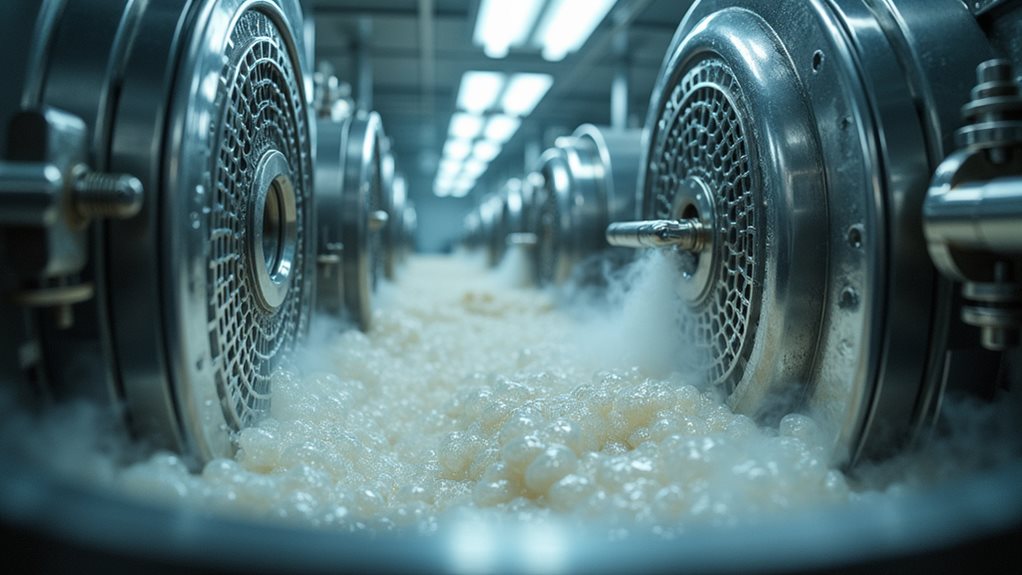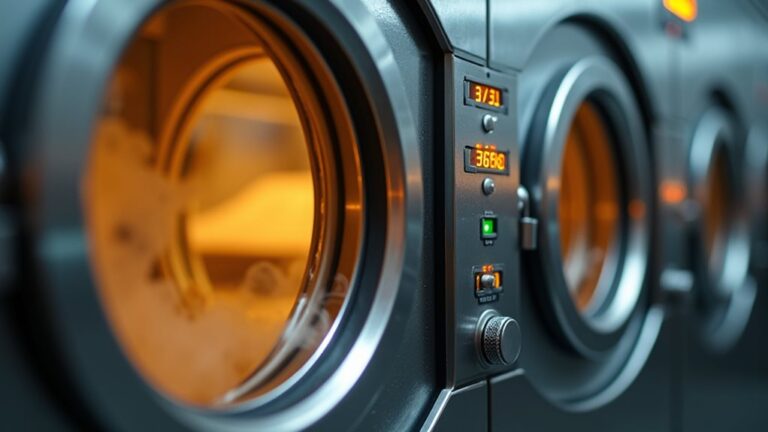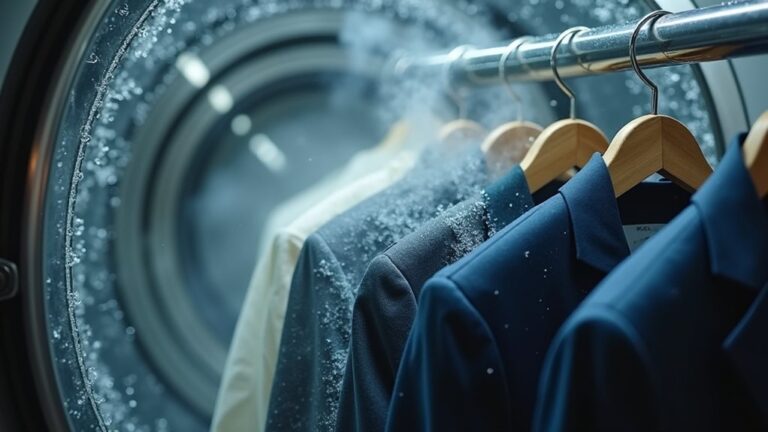You’re watching your clothes get a sophisticated spa treatment when you peek behind that dry cleaning counter – they’re actually soaked in special hydrocarbon solvents that work like gentle detergents to lift away oil-based stains that water simply can’t touch. The “dry” part happens during extraction and drying, where every drop of solvent disappears, leaving your garments refreshed without the shrinking or fading risks of traditional washing, and there’s so much more happening in this fascinating process.
Understanding the Solvent-Based Cleaning Method
When I first discovered that “dry” cleaning actually involves soaking clothes in liquid, I felt a bit like I’d been living a lie – sort of like finding out that white chocolate isn’t really chocolate at all 😅.
Here’s what actually happens: your delicate garments get dunked into hydrocarbon solvents, which are organic liquids that clean without water.
Think of it as giving your clothes a specialized bath where the solvent works alongside mechanical action and soap to lift away stubborn dirt and stains.
The magic happens when cleaners remove the solvent completely through extraction and drying, leaving zero residue behind.
This solvent-based approach protects fabrics that would shrink, fade, or get damaged if you’d thrown them in your regular washing machine with traditional water-based cleaning methods.
Dry cleaning is especially effective at removing oil-based stains that water simply cannot eliminate from your garments.
Debunking Common Myths About the Process
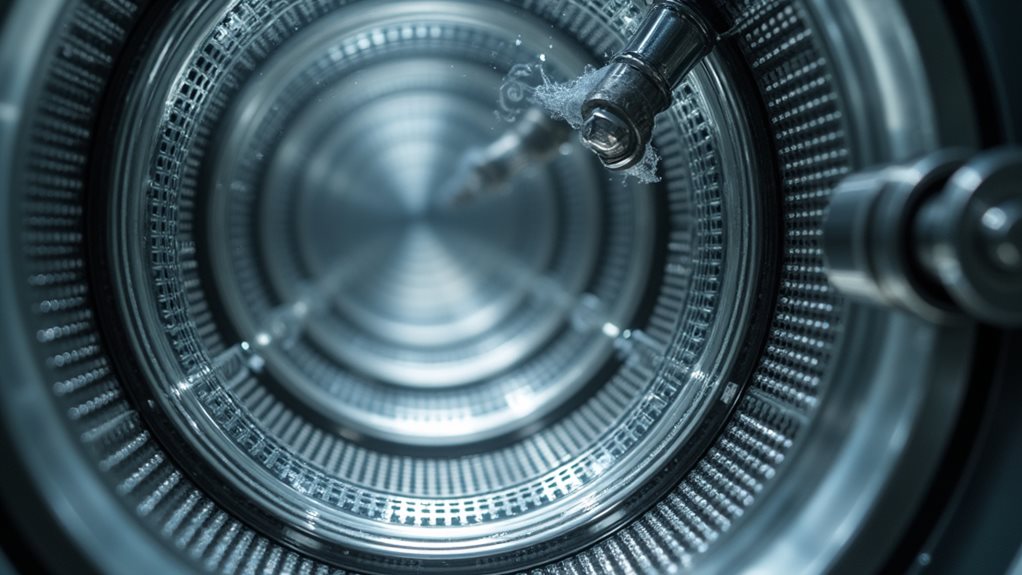
Why do so many of us walk around believing complete nonsense about dry cleaning?
I’ll admit, I used to think mysterious “dry-cleaning rays” magically zapped stains away 😅, but the reality’s actually more fascinating than fiction.
Here are the biggest myths you’ve probably heard:
These widespread misconceptions about dry cleaning persist despite the fascinating science behind this meticulous garment care process.
- It’s completely dry – Nope! Your clothes get wet with hydrocarbon solvents during cleaning.
- No quality control happens – Wrong again! Technicians inspect every button, lining, and seam carefully.
- Magical rays do the work – It’s actually mechanical action plus soap and solvent working together.
- Lint gets ignored – They remove every speck before your garments are ready for pressing.
Make sure you understand that dry cleaning’s a careful, scientific process.
The term “dry cleaning” itself is misleading because while it uses liquid CO2 or other chemical solvents instead of water, the process still involves immersing clothes in liquids.
Next time someone spreads these myths, you’ll know better!
Mechanical Action and Soap Application Techniques
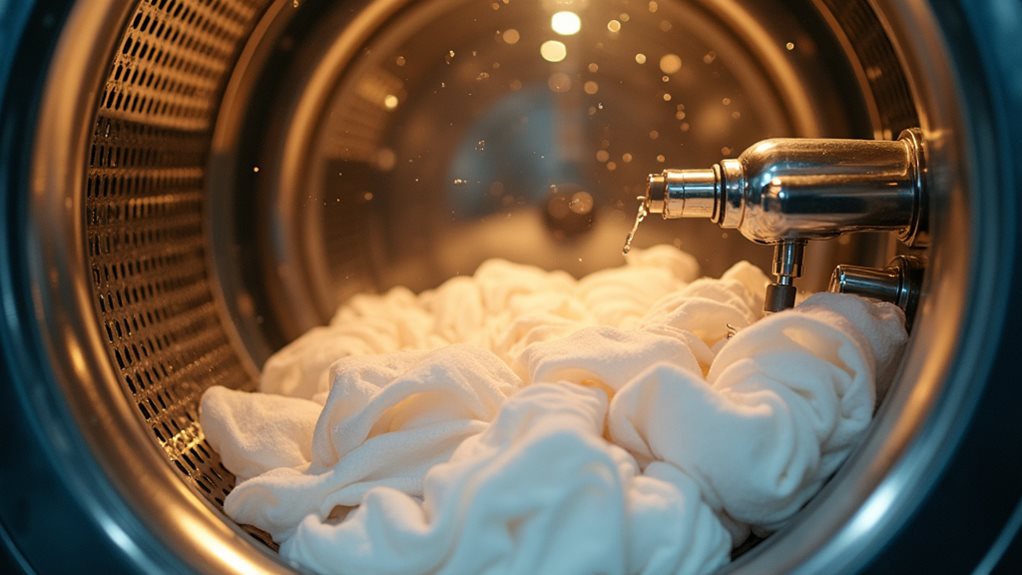
Picture your favorite wool sweater getting a gentle massage while being bathed in specialized cleaning solution – that’s fundamentally what happens during the mechanical action phase of dry cleaning.
You’ll witness your garments tumbling softly in cylindrical machines, creating mechanical action benefits that dislodge stubborn dirt without the harsh scrubbing you’d fear at home.
The soap emulsification techniques work like tiny molecular matchmakers, breaking down oily stains while the solvent penetrates deep into fabric fibers.
What amazes me most is how this process achieves garment integrity preservation – your delicate fabrics emerge looking refreshed rather than stressed.
Different detergents target specific stain types, guaranteeing your cashmere blazer receives completely different treatment than your synthetic workout gear, because one-size-fits-all rarely works in life! 😊
After the cleaning cycle, garments undergo solvent extraction and drying to remove any remaining chemical solution before the final finishing steps.
Solvent Removal and Drying Procedures
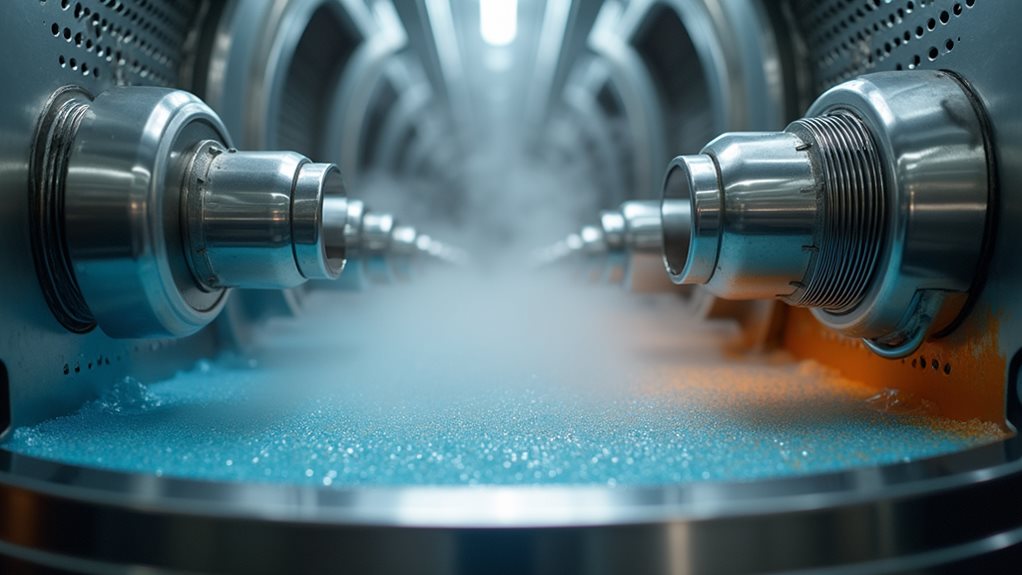
Once your clothes have been thoroughly cleaned in that hydrocarbon solvent bath, you’ll witness what I consider the most satisfying part of the entire process—watching specialized extraction machines gently coax every last drop of cleaning fluid from your garments, like a careful friend helping you squeeze water from a soaked sponge without tearing it.
The complete removal of solvent isn’t just about being thorough (though my perfectionist tendencies definitely appreciate that aspect 😊), it’s absolutely critical for preserving your fabric’s original texture and preventing any weird color shifts that could leave your favorite blazer looking like it went through a science experiment.
After extraction comes the drying cycle, where warm air or vacuum technology steps in to eliminate any lingering moisture, transforming your freshly cleaned clothes from damp and chemical-scented back to that crisp, ready-to-wear condition that makes you feel like you’re putting on brand-new garments.
Following the drying phase, your garments move on to pressing and steaming stations where professional equipment restores their original shape and eliminates any wrinkles that may have formed during the cleaning process.
Solvent Extraction Methods
After your garments have been thoroughly cleaned in the hydrocarbon solvent, the real magic happens during extraction, which is honestly where I learned that dry cleaning isn’t just about dunking clothes in chemicals and calling it a day.
The mechanical extraction process literally spins those solvents right out of your favorite sweater, and trust me, watching this happen for the first time was oddly satisfying 😊.
Here’s what makes extraction so effective:
- High-speed centrifugal force removes 99% of solvent from fabric fibers
- Multiple extraction cycles guarantee complete solvent recovery for environmental impact
- Different solvent types require specific extraction speeds and timing
- Advanced machines monitor extraction efficiency through precise weight measurements
This meticulous process protects both your clothes and our planet, because every drop of recovered solvent gets recycled back into the system.
Following extraction, the garments undergo a controlled drying phase that ensures any remaining solvent residue is completely eliminated before moving to the final pressing and steaming stages.
Complete Drying Cycle
The complete drying cycle represents the final frontier where your garments transform from solvent-dampened fabric back into the crisp, clean clothes you’ll actually want to wear, and I’ve got to admit, there’s something deeply satisfying about witnessing this metamorphosis firsthand.
Once mechanical extraction removes the cleaning solvent, your clothes enter a carefully controlled environment where drying methods vary from gentle air circulation to controlled heat application.
The drying efficiency depends on fabric type and garment construction, which honestly keeps dry cleaners on their toes.
While drying challenges can arise with delicate materials, the process maintains fabric integrity through precise temperature and airflow management.
A final inspection guarantees zero solvent residue remains before your garments proceed to pressing.
This meticulous approach ensures that sensitive materials like silk and wool retain their original texture and appearance throughout the entire process.
Initial Garment Inspection and Preparation
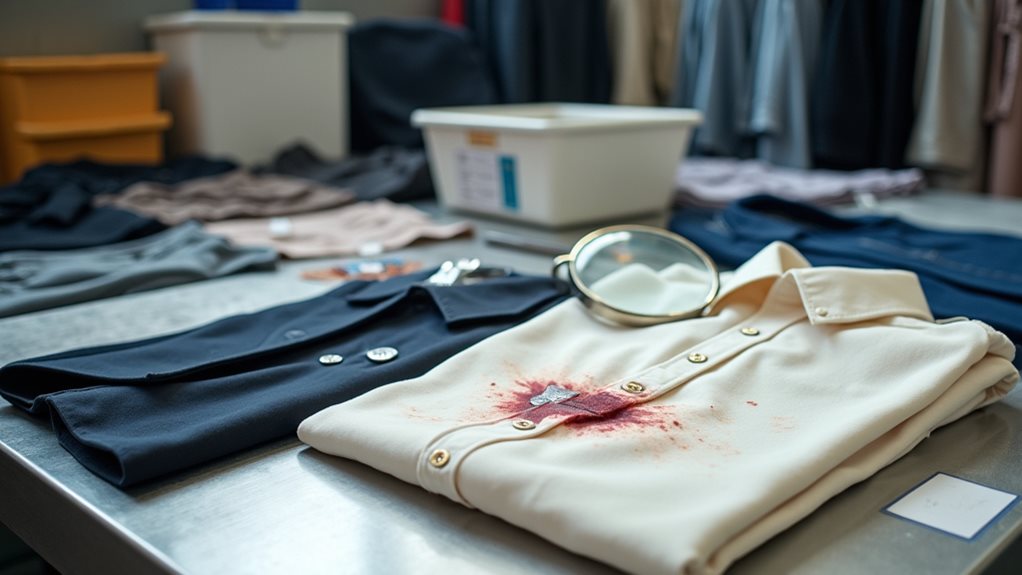
When you drop off your favorite shirt or that expensive blazer at the dry cleaner, you might think the magic happens immediately, but there’s actually a essential detective phase that occurs first.
Your dry cleaner becomes a garment CSI investigator, carefully examining every thread, button, and seam with inspection techniques that’d make Sherlock Holmes proud. This critical preparation stage determines whether your clothes emerge looking fabulous or, well, less than stellar.
Like a forensic expert with fabric, your dry cleaner’s meticulous pre-cleaning inspection is the difference between garment glory and disaster.
Here’s what happens during this thorough examination:
- Stain detection – Every spot gets catalogued like evidence at a crime scene
- Button security check – Loose buttons are identified before they become casualties
- Lint removal – Debris gets evicted to maximize cleaning effectiveness
- Garment categorization – Each piece gets sorted by cleaning requirements
During this inspection, cleaners also check care labels to determine the appropriate cleaning method and identify any special requirements for delicate fabrics or embellishments.
This detective work guarantees your clothes receive the perfect treatment they deserve.
Professional Pressing and Steam Treatment
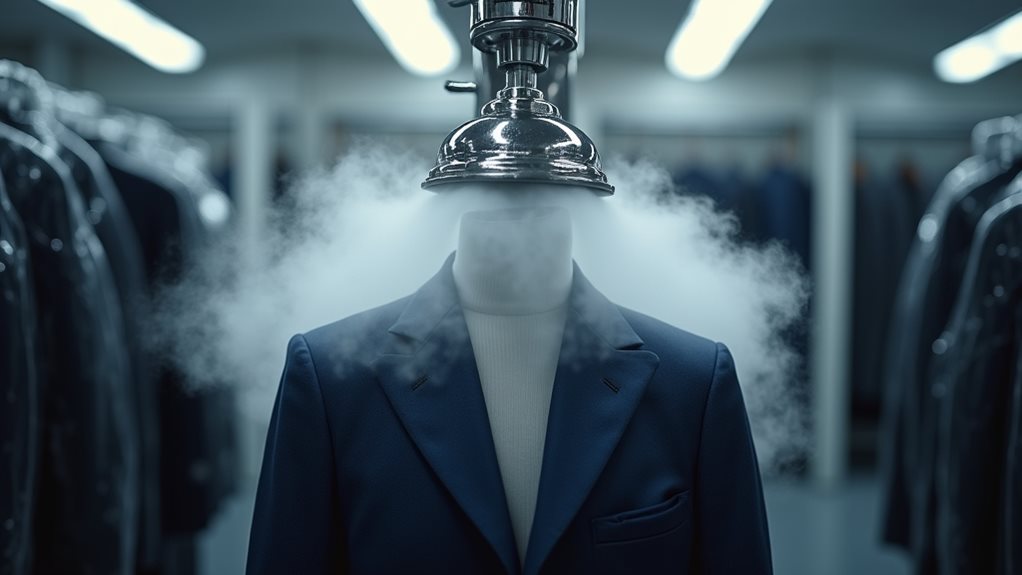
Once your freshly cleaned garments emerge from their chemical bath, they face what I like to call the “wrinkle apocalypse” – that unfortunate state where even the most expensive silk blouse looks like it’s been through a tornado.
Here’s where professional pressing techniques work their magic, transforming your crumpled clothing into crisp, ready-to-wear pieces that’ll make you look like you stepped off a magazine cover.
The steam quality during this process isn’t just hot air being blown around – it’s precision engineering that either vacuums moisture out or pushes it through fabric fibers, depending on what your garment needs.
This careful attention to pressing techniques doesn’t just better appearance; it actually improves garment longevity by maintaining structure and preventing premature wear that comes from improper handling.
Professional dry cleaners also provide specialized treatments for unique materials like leather and suede that require specific pressing methods to maintain their distinctive textures and properties.
Final Quality Control and Inspection Standards
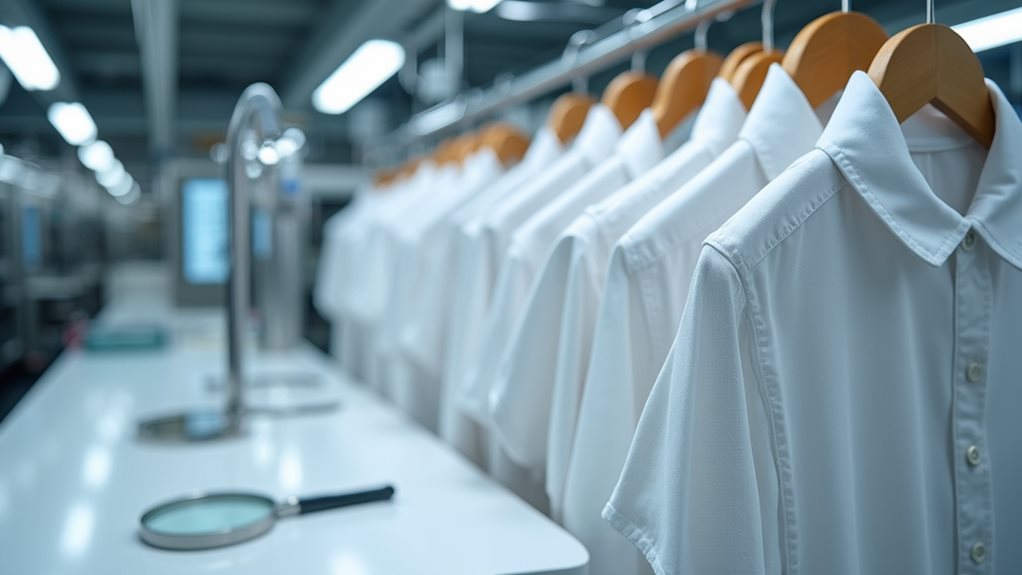
After your garments have been expertly pressed and steamed to perfection, they’re not quite ready for your closet yet – there’s one final, essential step that separates exceptional dry cleaners from the mediocre ones.
You’ll want to understand how thorough pre-delivery inspection processes work, because this is where experienced professionals catch those tiny details that could make or break your satisfaction with the service.
The quality assurance standards implemented during this final stage determine whether you’ll receive clothing that truly meets your expectations, or whether you’ll find yourself disappointed when you get home and notice a missed stain or loose button that should’ve been caught earlier.
This comprehensive inspection process also protects both you and the dry cleaner by documenting the garment’s condition before pickup, which can be crucial for resolving any disputes about damage or loss that might arise later.
Pre-Delivery Inspection Process
Five meticulous checkpoints stand between your freshly cleaned garment and the moment it’s placed in your hands, because honestly, there’s nothing worse than picking up your favorite blazer only to discover a lingering stain or a dangling button that somehow escaped notice.
These garment presentation techniques guarantee you’ll receive something that looks better than when you dropped it off, and trust me, that attention to detail makes all the difference in your confidence when wearing it.
- Lint and thread removal – Every surface gets scrutinized for those pesky fibers
- Button and hardware verification – Each fastener gets tested for security
- Lining attachment check – Internal components receive careful examination
- Overall cleanliness assessment – Final visual sweep confirms pristine condition
The inspection checklist importance can’t be overstated—it’s what separates professional customer satisfaction measures from disappointing pickup experiences. This quality control inspection ensures that delicate fabrics and structured garments receive the specialized care they require before being returned to customers.
Quality Assurance Standards
Because every garment deserves to meet exacting standards before it reaches your closet, professional dry cleaners implement rigorous quality assurance protocols that would make even the most detail-oriented perfectionist proud.
These quality control measures involve multiple inspection techniques that I’ve witnessed firsthand, and honestly, they’re more thorough than my own spring cleaning routine! 😅
Trained technicians scrutinize every seam, button, and fabric surface, guaranteeing ideal garment presentation through systematic visual assessments.
They’ll remove stubborn lint particles that somehow survive the cleaning process, check for loose threads that could unravel later, and verify that stains have completely disappeared.
This meticulous attention to detail means you’ll receive garments that look professionally refreshed, properly maintained, and ready to make you feel confident wearing them again.
Delivery Preparation and Presentation Standards
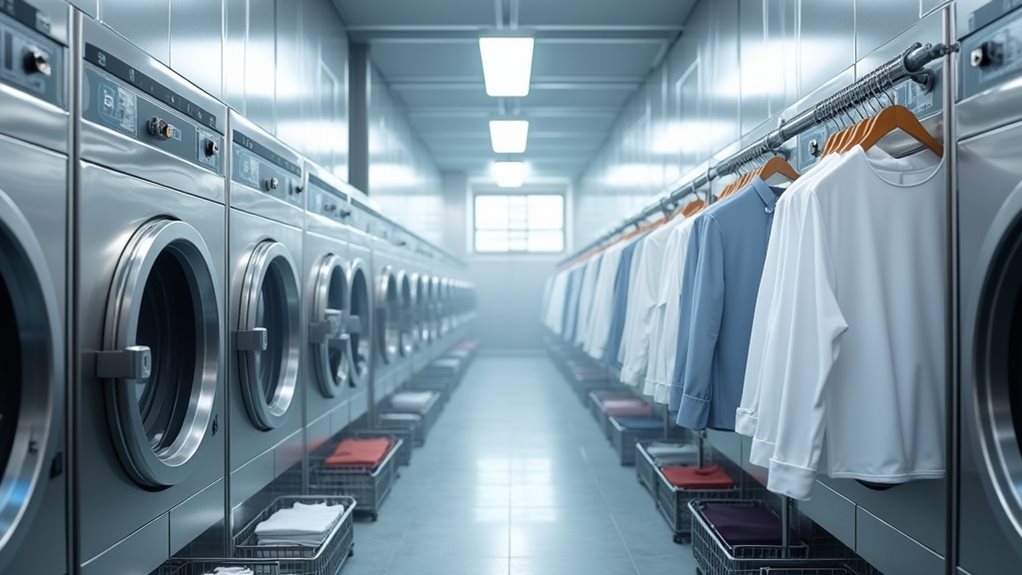
Three critical stages transform your freshly cleaned garments from simply processed items into presentation-ready pieces that’ll make you smile when you see them hanging in your closet.
These garment presentation techniques form the backbone of exceptional service, turning what could be ordinary into something special.
These presentation techniques elevate routine garment care into exceptional service that transforms ordinary cleaning into something truly special.
Your clothes undergo meticulous preparation that directly impacts customer satisfaction factors through attention to detail:
- Thorough button inspection and lint removal after the cleaning cycle
- Professional steaming followed by careful visual quality checks
- Final examination for any remaining threads, stains, or imperfections
- Complete quality control verification before packaging
This delivery process efficiency guarantees you’re receiving garments that meet the highest cleanliness standards.
When dry cleaners maintain these presentation standards, they’re not only processing fabric – they’re preserving your confidence and improving your satisfaction with every perfectly prepared piece.

